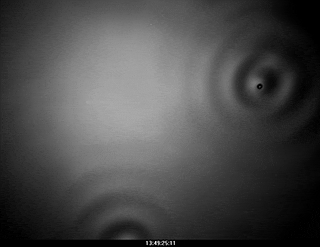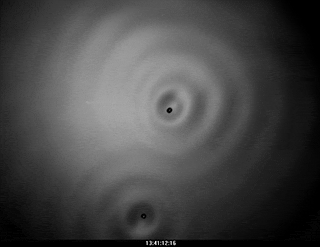Film III.1. Close-up of a walker
Walkers
While studying bouncing droplets on various fluid baths we had the surprise to observe that in a narrow range of values of the control parameters, some droplets moved horizontally on the fluid interface at a constant speed. The film III.2 is one of the videos recorded soon after this initial observation. We also saw that two droplets could bind and have an orbital motion around each other. This was the starting point of the PhD thesis of Suzie Protière [T1] in which this "walking" behaviour was first investigated and characterized.
Film III.2. The first observations of a walker
Real time video of a walker moving in a square tank of size 12x12 cm. The bouncing frequency and wave emission are stroboscoped by the video recording. The velocity of the droplet is approximately 10mm/s.
We called "walker" [P2, P3, P4] the coherent object formed by the association of the droplet and the wave-field it generates [ref 5-8]. In spite of the system being dissipative, this self-propagative structure is sustained. The bath oscillation provides energy both to the drop (to maintain its bouncing) and to the waves (through their parametric forcing). It is a symbiotic association: if the drop coalesces with the bath, the wave vanishes. Inversely, if the waves are damped (for example in regions where the liquid layer is thin), the drop stops travelling.
Film III.3 & III.4. Close up and slow motion of a walker as seen from the side and from above
These two fast camera recordings show the walking basic process. It results from a spontaneous breaking of the bouncing symmetry. At each collision with the interface the drop hits the forefront of the central bump of the wave created by the previous impacts. This shock on a slanted surface gives the drop a horizontal kick that will be repeated at the next period so that it will move at a constant mean velocity.
Walkers interactions
When several walkers coexist on the same bath, they have long-distance interactions due to the superposition of their waves. In order to characterize this interaction, we organized controlled "collisions" between two identical walkers moving initially towards each other along straight parallel trajectories. The distance d between these lines defines, as usual, the impact parameter of the collision.


Films III.5 & III.6. Two examples of repulsive collisions
On the left : A rare case of a head-on collision. On the right : Wave mediated repulsion
Film III.7. A wave-mediated attractive collision of two walkers and their mutual capture into an orbiting state
We found [P4, T1] that, depending on the value of d, the interaction is either repulsive or attractive. When repulsive, the two drops follow two hyperbolic trajectories (Film III.5 and III.6). When attractive, there is usually a mutual capture of the two walkers into an orbital motion similar to that of twin stars (Film III.7). The possible orbits have discrete diameters dn that are related to the Faraday wavelength dn=(n-ε)λF. If the drops bounce in phase n is one of the successive integers 1, 2, 3..., if they bounce with opposite phases n = 1/2, 3/2, 5/2... The shift ε is a constant: ε = 0.2. As shown on the slow motion films III.4 and III.5 the observed diameters correspond to those distances for which, at each impact with the surface, a droplet falls on the internal edge of the circular wave produced by the other. Repeated collisions thus provide the attractive force responsible for the orbital motion.
Film III.8. Slow motion of two orbiting walkers bouncing in phase
Film III.9. Slow motion of two orbiting walkers of opposite phases
Film III.10. The tightest possible orbit of two walkers of opposite phases
The collisions of two walkers at a small angle can also lead to the binding of the drops in a mode where they propagate together in parallel direction [P22]. In this "promenade mode" the distance of the drops can oscillate as shown on film III.11.
Film III.11. A pair of walkers bound in a "promenade" mode
Bibliography
Publications
[P2] Walking and orbiting droplets (PDF)
Y. Couder, S. Protière, E. Fort and A. BoudaoudNature 437, 208 (2005)
[P3] The self-organization of capillary wave sources (PDF)
Suzie Protière, Yves Couder, Emmanuel Fort and Arezki BoudaoudJ. Phys.: Condens. Matter 17 S3529_S3535 (2005)
[P4] Particle-wave association on a fluid interface (PDF)
S. Protière, A. Boudaoud and Yves CouderJ. Fluid Mech. 554, 85-108 (2006)
[P8] Exotic orbits of two interacting wave sources (PDF)
S. Protière, S. Bohn, and Y. CouderPhys. Rev. E 78, 036204-1-12 (2008)
[P22] Interaction of two walkers : Wave-mediated energy and force (PDF)
C. Borghesi, J. Moukhtar, M. Labousse, A. Eddi, E. Fort and Y. CouderPhys. Rev. E, 90, 063017 (2014)
Thesis
[T1] Gouttes rebondissantes : une association onde-particule à échelle macroscopique (PDF)
Suzie Protière, Thèse de Doctorat de l’Université Paris-Diderot, 25 octobre 2007
References
[ref 1] On the forms and states of fluids on vibrating elastic surfaces
Faraday, M.Phil. Trans. R. Soc. Lond. 52, 299 (1831)
[ref 2] Experimental study of the Faraday instability
Douady, S.J. Fluid Mech. 221, 383-409 (1990)
[ref 3] Patterns and quasi-patterns in the Faraday experiment.
Edwards, W. S. & Fauve, S.J. Fluid Mech. 278, 123-148 (1994)
[ref 4] Parametric instability of the interface between two fluids
Kumar, K. & Tuckerman, L.S.J. Fluid Mech. 279, 49-68 (1994)
[ref 5] Dynamics of a bouncing droplet onto a vertically vibrated surface
Vandewalle, N., Terwagne, D., Mulleners, K., Gilet, T. & Dorbolo, S.Phys. Rev. Lett. 100, 167802 (2008)
[ref 6] Drops bouncing on a vibrated bath : towards a hydrodynamic pilot-wave theory
Moláček J and Bush J W MJ. Fluid Mech. 727, 612-647 (2013)
[ref 7] Pilot-wave hydrodynamics
Bush, J.W.MAnn. Rev. Fluid Mech. 49, 269-292 (2015).
[ref 8] Faraday pilot-wave dynamics: modelling and simulation
Milewski, P.A., Galeano-Rios, C.A., Nachbin, A. and Bush, J.W.M.,J. Fluid Mech. 778, 361-388 (2015)